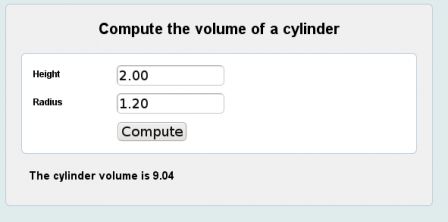In a previous article, I presented in the cylinder volume example the Ada Server Faces presentation layer and then the Ada beans that link the presentation and ASF components together. This article explains how to implement an action bean and have a procedure executed when a button is pressed.
Command buttons and method expression
We have seen in the presentation layer how to create a form and have a submit button. This submit button can be associated with an action that will be executed when the button is pressed. The EL expression is the mechanism by which we create a binding between the XHTML presentation page and the component implemented in Java or Ada. A method expression is a simple EL expression that represents a bean and a method to invoke on that bean. This method expression represent our action.
A typical use is on the h:commandButton component where we can specify an action to invoke when the button is pressed. This is written as:
<h:commandButton id='run' value='Compute'
action="#{compute.run}"/>
The method expression #{compute.run} indicates to execute the method run of the bean identified by compute.
Method Bean Declaration
Java implements method expressions by using reflection. It is able to look at the methods implemented by an object and then invoke one of these method with some parameters. Since we cannot do this in Ada, some developer help is necessary.
For this an Ada bean that implements an action must implement the Method_Bean interface. If we take the Compute_Bean type defined in the Ada beans previous article, we just have to extend that interface and implement the Get_Method_Bindings function. This function will indicate the methods which are available for an EL expression and somehow how they can be called.
with Util.Beans.Methods;
...
type Compute_Bean is new Util.Beans.Basic.Bean
and Util.Beans.Methods.Method_Bean with record
Height : My_Float := -1.0;
Radius : My_Float := -1.0;
Volume: My_Float := -1.0;
end record;
-- This bean provides some methods that can be used in a Method_Expression
overriding
function Get_Method_Bindings (From : in Compute_Bean)
return Util.Beans.Methods.Method_Binding_Array_Access;
Our Ada type can now define a method that can be invoked through a method expression. The action bean always receives the bean object as an in out first parameter and it must return the action outcome as an Unbounded_String also as in out.
procedure Run (From : in out Compute_Bean;
Outcome : in out Unbounded_String);
Implement the action
The implementation of our action is quite simple. The Radius and Height parameters submitted in the form have been set on the bean before the action is called. We can use them to compute the cylinder volume.
procedure Run (From : in out Compute_Bean;
Outcome : in out Unbounded_String) is
V : My_Float;
begin
V := (From.Radius * From.Radius);
V := V * From.Height;
From.Volume := V * 3.141;
Outcome := To_Unbounded_String ("compute");
end Run;
Define the action binding
To be able to call the Run procedure from an EL method expression, we have to create a binding object. This binding object will hold the method name as well as a small procedure stub that will somehow tie the method expression to the procedure. This step is easily done by instantiating the ASF.Events.Actions.Action_Method.Bind package.
with ASF.Events.Actions;
...
package Run_Binding is
new ASF.Events.Actions.Action_Method.Bind
(Bean => Compute_Bean,
Method => Run,
Name => "run");
Register and expose the action bindings
The last step is to implement the Get_Method_Bindings function. Basically it has to return an array of method bindings which indicate the methods provided by the Ada bean.
Binding_Array : aliased constant Util.Beans.Methods.Method_Binding_Array
:= (Run_Binding.Proxy'Unchecked_Access, Run_Binding.Proxy'Unchecked_Access);
overriding
function Get_Method_Bindings (From : in Compute_Bean)
return Util.Beans.Methods.Method_Binding_Array_Access is
begin
return Binding_Array'Unchecked_Access;
end Get_Method_Bindings;
What happens now?
When the user presses the Compute button, the brower will submit the form and the ASF framework will do the following:
- It will check the validity of input parameters,
- It will save the input parameters on the
computebean, - It will execute the method expression
#{compute.run}:- It calls the
Get_Method_Bindingsfunction to get a list of valid method, - Having found the right binding, it calls the binding procedure
- The binding procedure invokes the
Runprocedure on the object.
- It calls the
Next time...
We have seen the presentation layer, how to implement the Ada bean and this article explained how to implement an action that is called when a button is pressed. The next article will explain how to initialize and build the web application.
